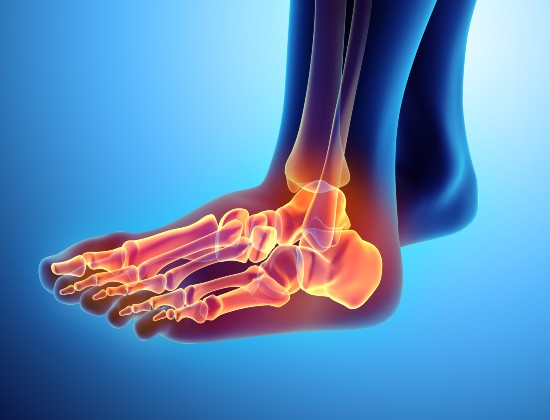Heel pain
The traditional term for this common painful problem is ‘policeman’s heel’ (based on the idea of too much time spent ‘walking the beat’).
What causes it?
Heel pain is often caused by inflammation - Plantar means ‘sole’ and fasciitis means ‘inflammation of the fascia’. Fascia is the thick lining of the sole of the foot which is attached to the heel and fans forward towards the toes, like a bowstring, maintaining the foot arch.
Plantar fasciitis is the commonest cause of heel pain. However, it may also be caused by:
- A stress fracture of the heel bone (calcaneus)
- Osteoarthritis in the sub-talar joint
- Thinning of soft tissue over the heel
- Irritation of small nerves around the heel
What are the symptoms?
- It can start as a dull heel pain that comes and goes, which may progress to being a sharp, persistent pain
- Pain may also be felt in the arch of the foot
- Pain is often worse when first standing after resting, typically when getting out of bed
People often live with the symptoms for many years before seeking medical help. If you decide not to see your doctor, you may continue to feel pain or it may go away naturally over a period of around 18 months.
What can make heel pain worse?
Factors that may make the condition worse include:
- Mechanical imbalances in the foot such as high arched or flat feet
- Hard soled or non-supportive shoes
- Regular running or long distance walking, or performing sports on hard surfaces which puts the fascia under tension and can lead to inflammation
- Increased body weight
- Reduced calf and hamstring muscle length, and restricted ankle joint movement
How is it diagnosed?
It can usually be diagnosed during a consultation with your specialist, without the need for an X-ray.
What if I have a bone spur?
A bone spur is a small spike of bone directly under the sole of the heel. It will not usually cause pain and is unlikely to need to be removed.
How is it treated?
The vast majority of cases are treated non-operatively using a combination of therapies to treat the symptoms, including:
- Rest, ice, compression and elevation (RICE)- The best way is to apply ice is to put some in a towel and place onto the swollen area for around 20 minutes, several times a day. Do not apply ice directly to the swelling as it may cause a ‘burn’. Rest your foot, elevating it (raising it above the level of your heart) as much as possible
- Medication - If the pain is recent, your doctor may advise painkillers and anti-inflammatory medication along with heel pads for a while to see if this helps
- Physiotherapy - You may be referred to a physiotherapist for a programme of specific stretches and exercises which can dramatically improve the symptoms by reducing inflammation and strengthening the foot muscles to support the weakened plantar fascia
- Night splints - Splints can keep the foot stretched and the ankle at right angles while you sleep, so that symptoms can be improved
- Insoles/heel pads - Shock absorbing heel pads or special insoles to reduce the sharp pain when walking can help improve your symptoms
- Taping - Taping your foot to maintain the arch can help some people by taking pressure off the plantar fascia
- Shockwave therapy - In cases where the other therapies have failed to improve the symptoms, shockwave therapy can sometimes be effective
- Steroid injections - If other therapies are unsuccessful you may be offered steroid injections. However, these carry a small risk of infection, increased pain and damage to heel-pad tissues
Surgery
An operation can be performed if symptoms are significant and carry on for over 12 months despite trying non-operative therapies. Around 60% of operations are successful
Can I still carry on with sport?
Heel pain can be made worse by weight-bearing sports such as running. It’s better to maintain your fitness by switching to alternative sports such as swimming while you recover.
Important: This information is only a guideline to help you understand your treatment and what to expect. Everyone is different and your rehabilitation may be quicker or slower than other people’s. Please contact us for advice if you’re worried about any aspect of your health or recovery.


